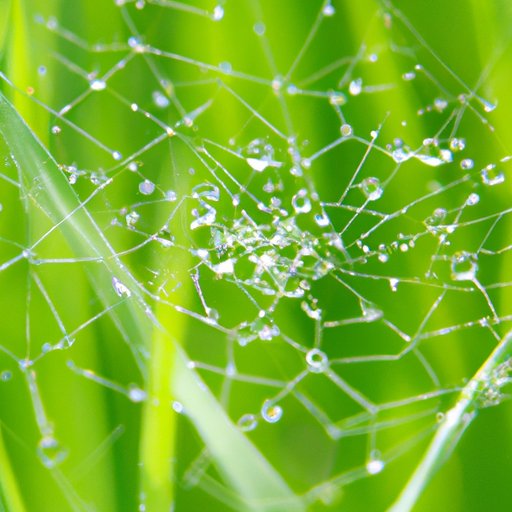I. Introduction
Have you ever woken up to a garden covered in tiny water droplets or seen a spider’s web adorned with sparkling beads? That’s dew! Dew is a natural phenomenon that occurs when moisture in the air condenses on cool surfaces, such as grass, leaves, or spider webs. In this article, we’ll explore the science, beauty, and significance behind dew.
A. Definition of dew
Dew is composed of water droplets that form during the night as a result of atmospheric cooling. It is essentially moisture that has condensed on surfaces that are colder than the surrounding air. Dew formation occurs when the temperature drops below the dew point, which is the temperature at which the air becomes saturated and unable to hold any more water vapor.
B. Importance of understanding dew formation
Understanding how dew forms is important because it has a significant impact on plant growth, weather forecasting, water conservation, and climate change. Additionally, the beauty of dew drops has inspired artists, poets, and writers for centuries.
II. The Science behind Dew: Understanding Its Formation and Significance
A. Explanation of dew formation
Dew formation occurs when moisture from the air comes into contact with cool surfaces. This causes the moisture to condense and form water droplets. The temperature at which this occurs is known as the dew point. The dew point is influenced by several factors, including humidity, temperature, and wind speed.
B. Factors that affect dew formation
The amount of dew that forms on a surface is affected by various factors including air temperature, humidity, and wind speed. Higher humidity levels and lower temperatures increase the likelihood of dew formation. Reduced wind speeds also increase the amount of dew that forms since it allows surfaces to cool more effectively.
C. Significance of dew in the environment
Dew plays a crucial role in the environment by providing moisture to plants and other organisms. It also helps to regulate temperature and humidity levels. Additionally, dew can aid in water conservation by providing a source of potable water in arid regions.
III. Morning Dew: A Beautiful Phenomenon or a Gardener’s Nightmare?
A. Effects of morning dew on plants
While dew can be a beautiful sight on plants, it can also be problematic. Excessive dew can create a damp environment that promotes the growth of fungal diseases such as powdery mildew. Dew can also cause damage to plants by breaking down the waxy coating on leaves, leading to damage and death.
B. Ways to prevent dew damage to plants
Gardeners can prevent dew damage to plants by planting them in areas with good air circulation and providing proper drainage. Additionally, avoid watering plants in the late afternoon to prevent excessive moisture on foliage. It’s also important to prune plants regularly to promote healthy growth and reduce the risk of fungal diseases.
C. How morning dew creates beautiful landscapes
Dew can create stunning landscapes, from the shimmering drops on spider webs to the sparkling droplets on leaves. These images are often captured by photographers who appreciate the fleeting and ephemeral nature of dew.
IV. From Grass to Spider Webs: The Unseen Wonders of Dew Drops
A. Different textures and shapes of dew drops
Dew drops come in various shapes and sizes, from tiny spheres to elongated teardrops. They can also have different textures, depending on the surface they are resting on. Some surfaces create clear, defined droplets, while others create irregularly shaped droplets.
B. Unique properties of dew drops
Dew drops have unique properties that make them fascinating for scientists and naturalists alike. For instance, they act like tiny lenses and can refract light in unusual ways, creating a miniature upside-down image of the world around them. Dew drops also have sticky surfaces that can trap small insects.
C. Unseen wonders of dew drops in nature
Dew drops play an important role in nature by providing moisture to plants and other organisms. They also create microclimates that promote the growth of certain species. Additionally, dew drops can capture and disperse pollen, contributing to the reproduction of plants.
V. Dew Drops and Climate Change: How Global Warming is Affecting Dew Formation
A. Impact of climate change on dew formation
Climate change is having a significant impact on the formation of dew. As temperatures rise, dew points are also increasing, meaning there is less likelihood of seeing dew.
B. Changes in precipitation patterns affecting dew formation
Changes in precipitation patterns are also affecting dew formation. As rainfall becomes more erratic, dew points are becoming less predictable, meaning that it is becoming harder for plants and animals to rely on dew as a source of moisture.
C. Discussion on the significance of dew in the global ecosystem
Dew plays an important role in the global ecosystem by providing moisture to plants and other organisms, which is particularly critical during dry seasons. Additionally, dew plays a role in temperature regulation, which has a significant impact on weather patterns and climate stability.

VI. Dew Point: A Key Factor in Weather Forecasting Explained
A. Definition and explanation of dew point
The dew point is the temperature at which the air becomes saturated with water vapor, leading to the formation of dew. It is a key factor in weather forecasting since it helps meteorologists predict the likelihood of precipitation.
B. How dew point is used in weather prediction
Meteorologists use the dew point to determine the likelihood of rain and fog. When the dew point is higher, it indicates that the air is saturated with moisture and there is a higher likelihood of precipitation. Dew point is also used to calculate relative humidity, which is another important factor in weather forecasting.
C. Implications of dew point for different activities
The dew point has implications for many different activities, such as agriculture, outdoor recreation, and transportation. For instance, high dew points can make outdoor work more difficult by increasing humidity levels, while low dew points can lead to dry and desert-like conditions.
VII. The Symbolic Significance of Dew in Literature and Poetry
A. Historical significance of dew in literature
Dew has played a significant role in literature and poetry throughout the centuries. In many cultures, dew is associated with spirituality, purity, and renewal. Additionally, dew has been used as a symbol for growth, birth, and new beginnings.
B. Cultural interpretations of dew symbolism
Different cultures have interpreted dew symbolism in various ways. For instance, the ancient Greeks saw dew as a symbol of rebirth and the Middle Ages as a symbol of Christ’s purity. In Japan, dew has been associated with feminine beauty and renewal, while in China, dew has been seen as a symbol of good luck and longevity.
C. Discussion on the beauty, brevity and ephemeral nature of dew symbolism
Dew symbolism is often associated with beauty, brevity, and the fleeting nature of life. Many poets and writers have used dew as a metaphor for the transience of human existence and the impermanence of all things.
VIII. Dew Harvesting: A Sustainable Way to Collect Potable Water in Arid Regions
A. Definition of dew harvesting
Dew harvesting is the process of collecting moisture from the air in the form of dew, fog, or mist. It is a sustainable way to collect potable water in arid regions where rainfall is scarce.
B. Techniques used in dew harvesting
There are several techniques used in dew harvesting, including using mesh nets, plastic sheets, and fog collectors. Mesh nets are typically used in open fields, while plastic sheets are used in more confined areas. Fog collectors are used in areas where fog is prevalent.
C. Benefits and significance of dew harvesting in arid regions
Dew harvesting has several benefits, including providing a source of potable water for people and animals in arid regions. It also helps to reduce the likelihood of water-borne illnesses, which are often prevalent in areas with limited access to clean water. Additionally, dew harvesting can be done without significant environmental impact, making it a sustainable solution for water scarcity in dry regions.
IX. Conclusion
of main points
Dew is an important natural phenomenon that plays a significant role in both the environment and human culture. Understanding the science behind dew formation, its significance in the global ecosystem, and its cultural symbolism are key to appreciating this beautiful and fleeting phenomenon.
B. Final thoughts on the importance of understanding dew
While dew may seem like a trivial phenomenon, it has significant implications for plant growth, weather forecasting, water conservation, and global climate change. The beauty of dew drops is also a source of inspiration for artists and writers.
C. Call to action.
Take a moment to appreciate the next time you see morning dew on the grass or spider webs. Perhaps consider dew harvesting or support initiatives to reduce water scarcity in arid regions. Every small step counts towards a more sustainable and appreciative relationship with our environment.
